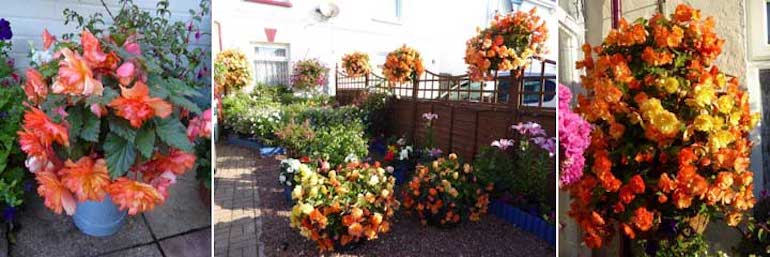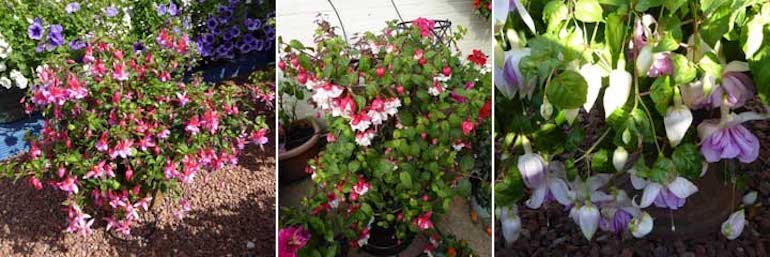
Begonia ‘Apricot Shades Improved’ F1 Hybrid adds colour & dimension to every part of your garden
Image: Thompson & Morgan
As part of a regular series, award-winning gardener Jean Willis explains her latest obsession with begonias and shares an honest account of the recent successes and failures in her fabulous container garden. If you’re looking for new begonia plants or fuchsias to try, Jean’s garden is the one to watch!
Plants to be passionate about – Begonia ‘Apricot Shades’

Begonia ‘Apricot Shades’ in Jean’s container garden
Image: Jean Willis
Passion or Obsession? This year I’ve planted over 200 Begonia ‘Apricot Shades’, bought as garden-ready plants. They’ve nearly all gone into hanging baskets, window boxes and tubs. I’ve been asked if I’m obsessed with them and, while I hadn’t really thought about it like that, maybe I am! I’m always thrilled when they’re all flowering, especially if I catch the early sun shining on them.
I recently had a head count and found I had a triple basket (12”, 14” and 16”) joined together by a chain that my husband made for me, 5 single hanging baskets, two half-baskets, a window box and several containers. Two half barrel containers are currently overflowing with apricot flowers.
Plants to be passionate about – Fuchsias

Fuchsias grow happily in containers or the ground
Image: Jean Willis
My other passion is fuchsias. I bought Fuchsia ‘Icing Sugar’ to try out last year, and they’ve been very successful. Another favourite fuchsia is called ‘Wendy’s Beauty’. It has a pretty mauve and white flower, and I grow these for my sister Wendy who lives in California.
This year I bought some Giant Flowered Fuchsias from T&M and they certainly grow like their name! This year, for something different, I’m growing a climbing fuchsia called ‘Swingtime’ in one of T&M’s tower pots; it has now reached the top of the trellis and is flowering profusely.
Having decided to grow petunias again this year after a couple of unsuccessful attempts, I’m now thinking that maybe I should have chosen something else. We’ve had such awful winds and rain that a couple of containers were completely destroyed one night, but I was pleased to discover that the Petunia ‘Night Sky’ and Petunia ‘Amore Queen of Hearts’ stood up to the rain quite well. I think I’ll grow smaller petunias in future, rather than the big ones, although I really like them.
Was it a bird? Was it a squirrel?

A sugar glider in full ‘flight’
Image: Jean Willis
…I actually found out later that it was a Sugar Glider from Australia! On my last visit to a garden centre, I saw something on the trunk of one of the Yucca trees just outside the entrance. As we got closer it looked like a baby squirrel but then it took off and jumped about 10 metres onto a wall covered in ivy. We watched it for a few minutes before it disappeared. On checking Google I found that Sugar Gliders are sometimes bought in this country as a pet but, because they’re very difficult to keep, they’re then let loose. I hope it survived all the rain we’ve had lately. I’m just grateful that Alan was with me; otherwise I might have thought I was seeing things!
I hope you’re all enjoying your gardens this summer. Don`t forget the sunscreen and hat! Until the next time…Happy Gardening.
Jean
Visit our comprehensive hub page for more help and information on growing begonias.
I started gardening 65 years ago on my Dad’s allotment and now live in Bournemouth, where spend a lot of time gardening since retiring. In 2012 I won the Gold Award for Bournemouth in Bloom Container Garden. I am a member of Thompson & Morgan’s customer trial panel.
















